Manitoba Insect & Disease Update
Issue 6: July 4, 2018
Summary
Diseases: Clubroot symptoms in canola have been reported. Sclerotinia apothecia were observed in the MacGregor area. Root rots continue to be reported in pulse crops, including soybeans and field peas. A suspected case of wheat streak mosaic virus has been reported from the RM of Macdonald. Early symptoms of sunflower rust were observed near Cypress River.
Insects: Some field edges and a few fields have had grasshopper populations controlled. Some field edges are being watched for grasshopper levels and whether there is much feeding to crops. Aphid levels in peas and cereal crops are still quite low. No soybean aphids have been reported yet.
BeeConnected: Protecting Pollinators and Crops
If pest insects appear to be at economic levels in a crop that is flowering, extra considerations are neccesary. Honey bees and pollinators are likely to be active in any flowering crop. Communication between farmers, agronomists and beekeepers can help minimize harm to bees.
An app called BeeConnected (http://www.beeconnected.ca/) can help prevent insecticide harm to honey bees. After registering as a user, farmers can register the location of their property. If a beekeeper registers the location of their beehives within 5km of a farmer’s property, both parties will be notified and will be able to discuss their activities further using the secure messaging service. If they wish, farmers may also register the time and specific location of crop protection activities they are planning, such as the spray application of pesticides.
When crops are flowering it is even more critical to use eceonomic thresholds when available. Some crops such as canola and sunflowers can produce good yields without pollinators, but will produce better yields with pollinators. So applying an insecticide when insect pest levels are below economic thresholds may inadvertently decrease both yield and profit by reducing or elimating the increase to yield that pollinators contribute. This is one of the reasons we highly discourage tank mixing in an insecticide when applying other pesticides to a flowering crop "just in case harmful insects are present". This is where good crop scouting can save you a lot of money by making sure you maximize the benefits from pollinators and other beneficial insects.
Clubroot
Canola plants showing clubroot symptoms were observed last week (Figure 1). The affected plants are located along a waterway in the field and the affected area covers at least 7 acres. The field, while a new clubroot case, is located in a rural municipality where clubroot symptoms have been previously observed. This finding will not change the Manitoba Clubroot Distribution Map. Best management practices for fields where clubroot is suspected or fields at higher risk (in RMs where clubroot has been detected) include a 3- or 4-year rotation, growing clubroot resistant varieties, and practicing good sanitation (knocking off soil, completing field work on affected fields last). Early detection is important for clubroot management, so be vigilant about scouting areas where plants are less vigorous and consider having a soil test done for the presence of clubroot DNA.
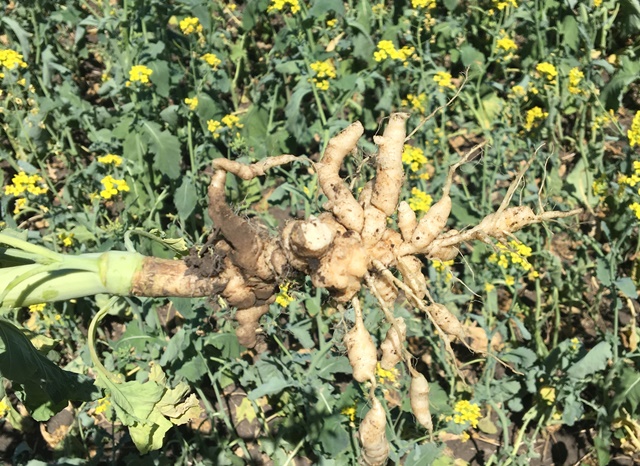
Figure 1. Clubroot symptoms observed in a Manitoba field last week.
Sclerotinia
Apothecia, the fruiting bodies of Sclerotinia sclerotiorum, were observed within the canopy of a wheat crop (on canola stubble) in the MacGregor area (Figure 2). This area has received more consistent moisture than many other areas of the province. In order for a sclerotia to germinate and produce apothecia, they require at least 10 days of moist soil conditions (surface soil - as only sclerotia within an inch or two of the surface will produce apothecia on the surface). Canola and dry beans in many areas of the province are through or at the stage when a fungicide application is being considered. Keep soil moisture conditions and humidity within the canopy in mind when making the decision of whether or not to spray.

Figure 2. Apothecia of sclerotinia (indicated by yellow arrows) observed near MacGregor (image courtesy of Amber Knaggs).
Root rot
There continues to be reports of suspected Phytophthora root rot in soybeans in the central region (Figure 3). Root rot in field peas is also showing up in the Hamiota area (Figure 3). If root rot is suspected in field peas samples should be sent in to the diagnostic lab to identify the causal agent. If Aphanomyces root rot is identified a rotation of 5 to 7 years between field pea crops is recommended. Typically when Aphanomyces root rot is present, Fusarium is present as well. Symptoms of Aphanomyces root rot include caramel-coloured root systems whereas Fusarium will show up as darker discolouration on the tap root.
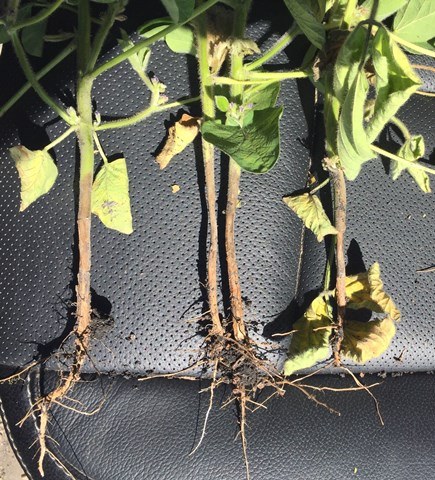
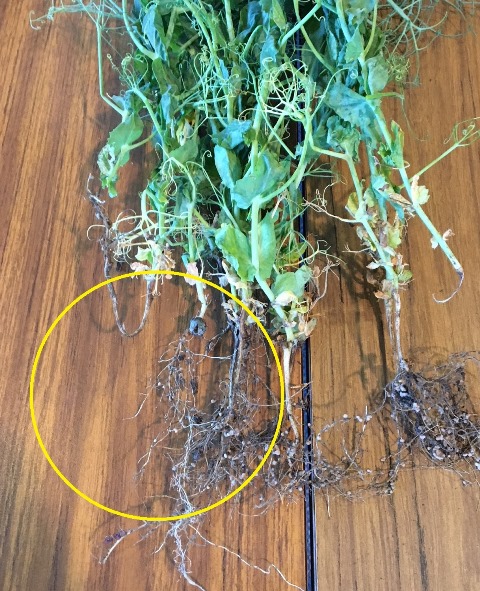
Figure 3. Root rot symptoms in soybean (left) and field pea (right). Affected roots of pea plants are circled. (Images courtesy of Jason Voogt (left) and Amir Farooq (right)).
Wheat Streak Mosaic Virus
Wheat streak mosaic virus is suspected in the RM of Macdonald. Spring wheat plants were submitted that exhibit typical symptoms of this disease (Figure 5) and a winter wheat field was located nearby. This disease is vectored by the wheat curl mite which overwinters on wheat and occassionally other grass species. The main method of control is by breaking the green bridge as the mites will not survive on plants that have dried down. If there is a period of time in the fall when the spring wheat has dried down and the winter wheat has not emerged the mites will be without a host and wheat streak mosaic virus will not spread. Samples from the suspected field have been sent to the Crop Diagnostic Lab for confirmation.

Figure 5. Suspected wheat streak mosaic virus symptoms in spring wheat.
Sunflower Rust
The aecial stage of the rust fungus in sunflower was observed this week in the Cypress River area on sunflower plants at the R1 stage (Figure 6). This disease overwinters on sunflower residue and it is typical to see the aecial stage at this time of year. If rust symptoms are observed it is important to continue scouting as the typical threshold for a fungicide application is 2 to 3% pustule coverage on the upper 4 leaves during the R5 growth stage.
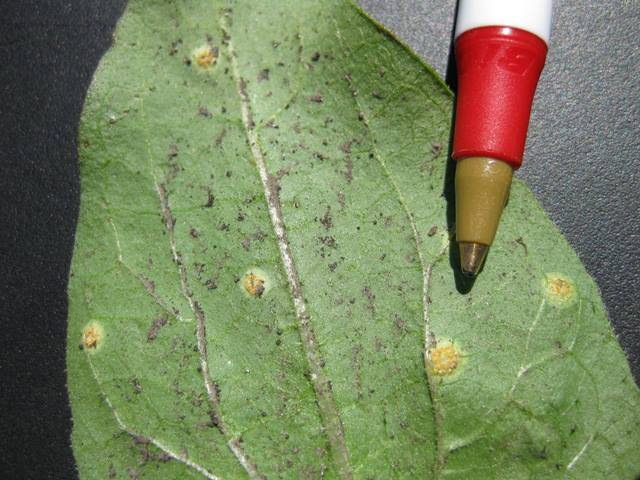
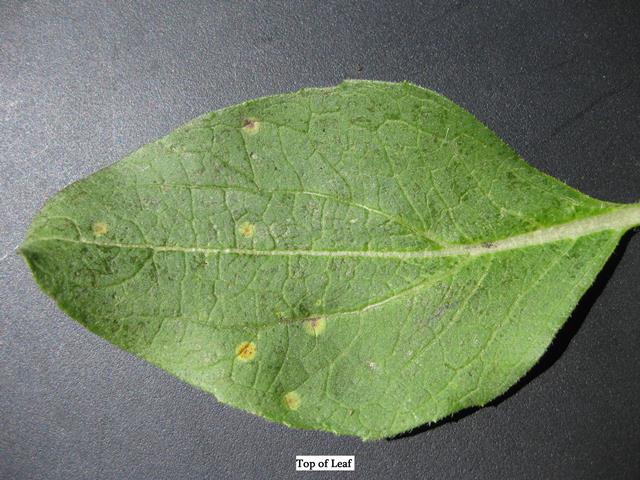
Figure 6. Aecial stage of sunflower rust on the lower (left) and upper (right) surfaces of a sunflower leaf (images courtesy of the National Sunflower Association).
Wheat Midge Emergence
Wheat midge emergence should be close to complte southern Manitoba, and around 50% in more northern areas. So for wheat fields that have headed but have not flowered yet, an evening trip to the field to assess levels of egg laying midge would be timely.
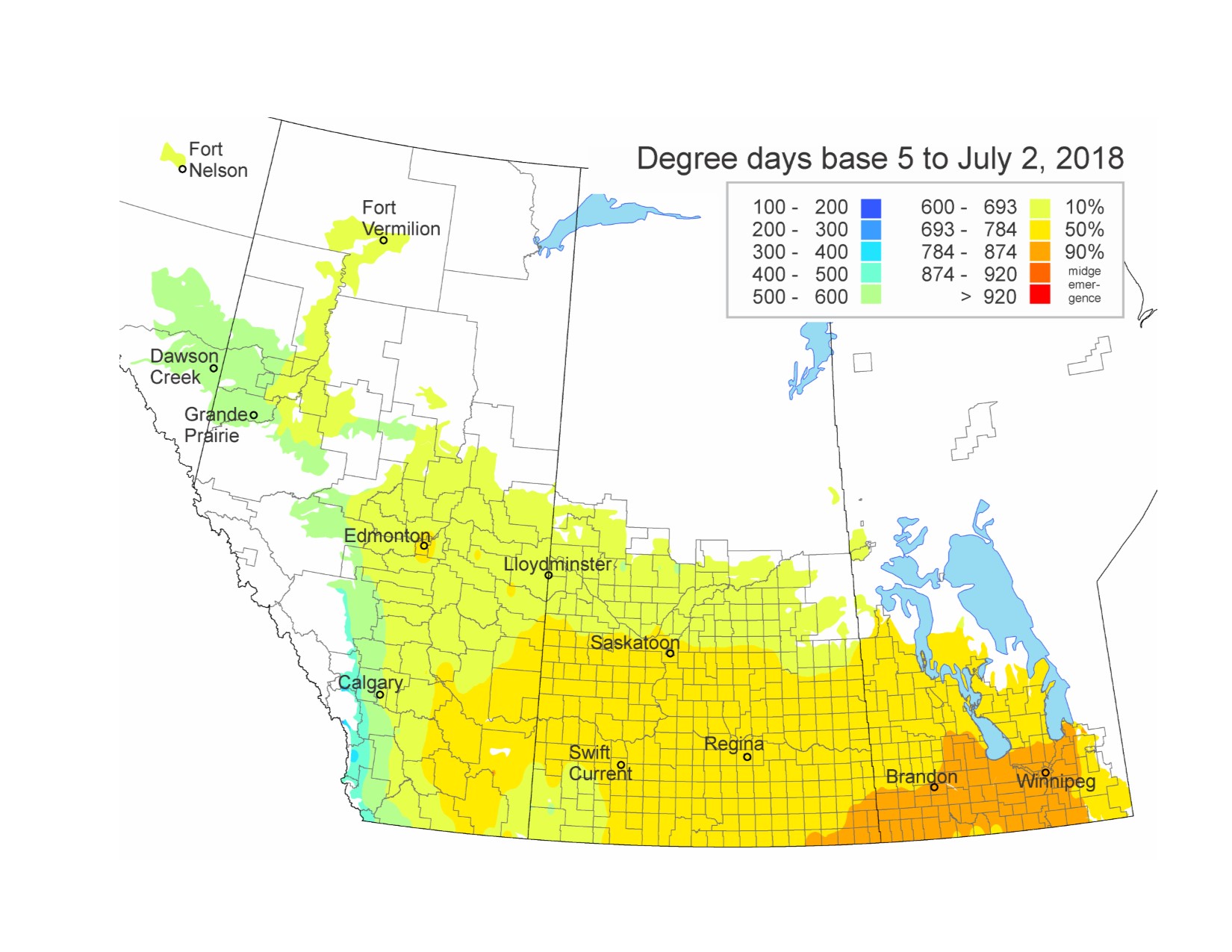
Wheat heads are susceptible to damage when egg laying occurs during heading, but prior to anthers being present on the head. If most of the wheat heads already have anthers, that field is no longer susceptible to wheat midge. Field inspection should be carried out between from about 75 minutes prior to sunset until about 30 minutes after sunset, when female midge are most active. Females are more active when the temperature is above 15°C and wind speed is less than 10 km/h.
Midge populations can be estimated by estimating the number of adult wheat midge per four or five wheat heads on average. Inspect the field in at least three or four locations. Midge densities at the edge and centre of fields may be very different. The highest densities are often next to fields where wheat was grown the previous year.
When yield is the only consideration, the suggested threshold is 1 adult midge for each four or five heads. When maintaining optimal grade is important, the suggested threshold is 1 adult midge per 8 to 10 wheat heads during the susceptible stage.
In most areas of Manitoba wheat midge has not been noted at high levels in recent years. This may be due to the parasitoid Macroglenes penetrans. This is why we emphasis to only apply an insecticide for wheat midge if populations are above the economic threshold. Application to fields with low midge levels may do more harm than good. If high populations of wheat midge are noted in any fields, please consider sending me a note (see contact information below) so we can track where any higher levels of wheat midge may be occurring.
Insect Monitoring Programs
Bertha Armyworm: Most of the highest cumulative counts so far are in the western part of Manitoba, with four traps in the uncertain risk category. All other traps are currently in the low risk category.
Table 1. Highest cumulative trap counts for bertha armyworm adults over the trapping period June 3 to July 4, 2018.
0-300=low risk 300-900=uncertain risk 900-1,200=moderate risk 1,200+=high risk
| Location | Region | Count | Risk |
|---|---|---|---|
| Tilston | Southwest | 714 | Uncertain |
| Somerset | Central | 445 | Uncertain |
| Pierson | Southwest | 337 | Uncertain |
| Benito | Northwest | 307 | Uncertain |
| Mather | Central | 247 | Low |
| Miniota | Southwest | 236 | Low |
| Killarney | Central | 211 | Low |
| Inglis | Northwest | 186 | Low |
| Inglis | Northwest | 178 | Low |
Diamondback Moth: Monitoring adults of diamondback moth with pheromone baited traps has been underway since the beginning of May. Trapping is now complete. Highest counts have been in the Central region and Interlake, but overall levels are generally low . Out of ninety-one traps, 64 traps had cumulative counts under 10. Table 1 summarizes the highest cumulative counts in Manitoba.
Table 1. Highest cumulative trap counts for diamondback moth adults over the trapping period April 29 to June 30, 2018.
| Location | Count |
|---|---|
| Oak Bluff | 107 |
| Warren | 84 |
| Morris | 83 |
| Winnipeg Beach | 78 |
| Teulon | 71 |
| Balmoral | 49 |
All stages of diamondback moth have now been reported, and we are likely into our second generation of adult moths. So now the focus should be on looking for larvae, especially as canola starts to produce pods. If there is sufficient soil moisture canola can often compensate well for feeding in the bud and flower stages. So far no economic populations of diamondback moth larvae have been reported. Some pathogen infected diamondback moth larvae have been noted in the Northwest.
Insect Identification Quiz
You notice a cluster of these insects while scouting canola. What is this? And should you be concerned?

Answer: This is a blister beetle. There are many species of blister beetles; at least 20 species occur in Manitoba. This particular species is Nuttall's blister beetle, Lytta nuttalli. If you look carefully along the side of the body you will notice there are 3 white eggs, 1 on the right wing, and 2 on the abdomen. These are eggs from a parasitoid.
You will often see blister beetles in clusters in a field. They can emit an aggregation pheromone to attract other individuals to the cluster. Crop feeding in the cluster may be quite noticeable, but usually on a whole-field basis they are not economical to control.
Some species of blister beetles in the genus Epicauta will feed on grasshopper eggs. These are the black and grey blister beetles you often see. So some blister beetles do provide some agronomic benefits.
----------------------------------------------------------------------------------------------------------------------
Compiled by:
John Gavloski, Entomologist Holly Derksen, Field Crop Pathologist
Manitoba Agriculture Manitoba Agriculture
Phone: (204) 750-0594 Phone: (204) 750-4248
To report observations on insects or plant pathogens that may be of interest or importance to farmers and agronomists in Manitoba, please send messages to the above contacts.
To be placed on an E-mail list so you will be notified immediately when new Manitoba Insect and Disease Updates are posted, please contact John Gavloski at the address or numbers listed above.

